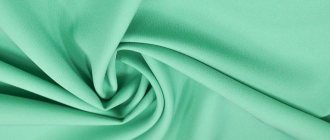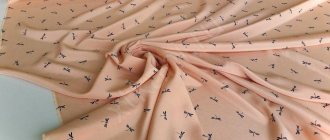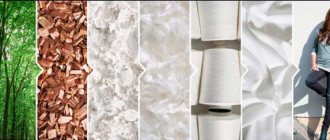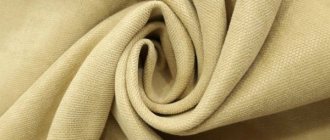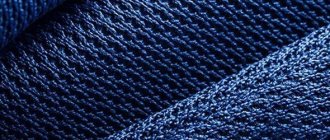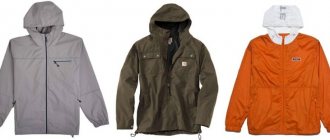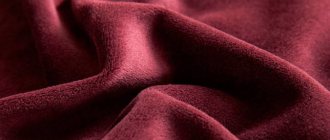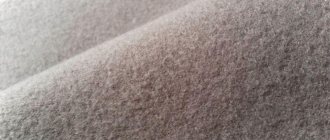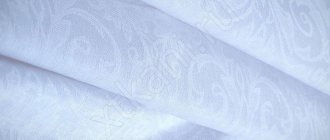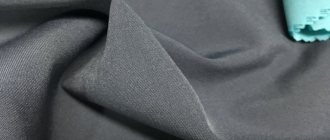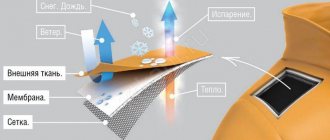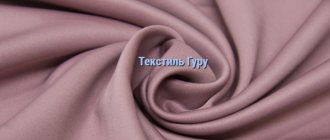Each item has its own role and place in any person’s wardrobe. There are jackets that you use for formal occasions, jackets that you use on casual days, and there are jackets that you wear for outdoor activities. As for the latter, there are so-called “hard” jackets - Hard shell (hardshell) and “soft” jackets - Soft Shell (softshell). Given the popularity of hardshells and the availability of a huge amount of information about them, let's talk about softshells. What is a softshell jacket and how does it fit into your wardrobe? What properties and features do softshell clothing have, and when do you really need it? In this article we will answer all these questions and describe everything you need to know about softshell clothing.
Type and general description
Softshell (Softshell translated from English means “soft shell”) is a type of fabric consisting of several membrane layers firmly welded to each other. The concept of the material, from which clothing is made mainly for athletes and other lovers of an active lifestyle, is to apply a top, durable layer of clothing on a soft bottom layer. There can be two or more layers.
Softshell colors
Due to this, the best performance properties of the softshell are ensured: it protects from wind and cold, practically does not allow water to pass through, is airtight, retains heat well and does not hinder movement.
As a rule, the outer side of a softshell resembles nylon in appearance and feel, and the inner side resembles fleece. Between the layers of material there is a membrane layer that can “breathe” and remove fumes to the outside. The softness of the underside adjacent to the body is achieved through the use of fine-fiber pile, which remains dry even with the most profuse sweating.
Nylon
What kind of fabric is this - nylon? What are its characteristics and properties?
more details
Fleece
What is known about fleece fabric? What are its characteristics and properties?
more details
Softshell is an opportunity to abandon all kinds of undershirts that hinder movement and increase the overall volume and weight of the equipment.
Softshell is produced in China, Pakistan, Turkey, Poland, Great Britain, Germany and some other countries. In Russia, the production of this type of fabric has not yet reached any significant volumes.
Varieties
Softshell fabric was the result of many years of research aimed at developing a material that protects from all the vagaries of the weather. The additional membrane and multi-layering make the fabric unique.
According to the structure, Softshell is divided into two types: membrane and membrane-free fabrics. Each of them is designed for a specific type of activity. The first one is not blown out and does not get wet. It is chosen for autumn hikes and winter holidays. The second type is designed for summer jogging and beach fun.
Membrane materials
Structurally, they consist of three layers: smooth stretch, membrane and fleece. Available in several types:
- Waterproof eVent. Replaces a storm jacket in urban and hiking conditions. The membrane makes the products durable and silent in motion, pleasant upon contact. The material is not completely blown and has a low degree of aeration.
- Windproof. At a normal level of humidity and little frost, it maintains sufficient ventilation and protects against wind and hurricanes. In everyday life, the fabric is used for demi-season clothing.
- With reduced wind protection. Used for intensive training. It has the ability to remove body evaporation even at high humidity. However, wind and moisture permeability are low.
Membraneless materials
Clothes made from this fabric are designed for dry and windless weather, but will get wet even in light rain. It is highly breathable.
The fabric structure contains only a layer of elastic stretch and soft fleece.
The following varieties are available:
- Traditional, replacing three-layer equipment. The top of this fabric is dense and heavy and hardly blows through. The inner level made of thick fleece reliably retains heat in temperatures down to -7°. The disadvantage of the material is the lack of elasticity and tight fit, which leads to heat loss.
- PolartecWindPro has a textile surface. It is valued by climbers for its good aeration and thermal insulation. Wind protection is determined by the density of the fabric.
- PolartecPowerStretch is an analogue of the first softshell samples. It is distinguished by its lightness and stretch properties. Warm material is used in clothing for active sports in cool, windless weather.
- Power Shield is the most breathable type, protecting against wind and precipitation.
History of the creation of the material
Humanity owes the appearance of the softshell to the Scottish climber Hamish Hamilton. In the mid-1980s, he began studying the traditional clothing of the Arctic indigenous people, trying to understand how they could survive without modern high-tech fleece and breathable fabrics.
And I came to the conclusion: the clothing of the northern peoples is much superior in design to any technical solutions available in the “civilized” world.
Namely: protection from the wind was guaranteed by the outer surface (animal skin), and the fur facing inward provided insulation and formed a microclimate. It was important for the local hunter not to freeze, not to get wet and to maintain freedom of movement - and all this was provided to him by a single layer of skin and fur.
After countless experiments, Hamilton achieved his goal. For the outer layer, he used a thin, durable synthetic fabric called Pertex (a type of nylon), and instead of slow-drying fleece, he used lint, which worked like a wetsuit, instead of slow-drying fleece.
What temperature are the products designed for?
In temperate climates, soft-shell clothing provides comfort during active movements and physical activity. The hydrophobic layer creates optimal microclimate characteristics with low weight and a minimum of things.
At sub-zero temperatures and strong, stormy winds, items are combined with thermal underwear and warm fleece jackets. The scheme of three-layer hard-shell clothing works here.
A softshell with a 100% windproof membrane should be worn in autumn and spring instead of a raincoat or thin jacket. Take it with you on one-day climbs and short hikes. To protect against sudden rain, take a polyethylene cape. Things based on pore membranes are suitable for winter ascents.
Products made from membrane-free materials require an additional layer of clothing to avoid getting wet in the rain or freezing from strong winds.
Fabric composition and properties
Softshell materials do not have a single set of components common to all; the composition varies depending on the conditions of use. The fabric consists of several layers that are firmly connected to each other by layering. The outer layer is always a durable material that is maximally resistant to stress and abrasion. The inner layers must be soft and breathable.
Typically, in the production of softshells, synthetic materials such as polyester, polyamide, polypropylene, polyurethane, and lycra are used. The most common combination is nylon (as the outer layer) and polyester.
Lycra
What is Lycra fabric and what are its features? What are the characteristics and areas of use?
more details
The purpose of the fabric determines its properties. Softshell is always:
Freedom of movement
Air or vapor permeability
Elasticity
Application
The popularity of softshells is constantly growing and finding new areas of use. After all, a jacket made of such material looks like an ordinary jacket and at the same time hides great protective capabilities. It is in demand not only for sportswear, but also in everyday wardrobe, in the military industry and for outfitting rescuers.
The material is versatile, suitable for adults and children. Summer and demi-season clothes are made from it. This includes trousers, overalls, bomber jackets, hoodies, jackets, shirts, slacks, windbreakers, blazers, tracksuits for women and men, overalls and uniforms.
Types of fabric
Depending on the production technology and the number of layers, softshells can be classified into:
- Two-layer - consisting of two compressed layers: top and pile (or fleece). Ideal for dry, windless and not too cold weather.
- Three-layer - top, membrane and pile (fleece). In this option, the bottom layer removes evaporation and retains heat, and the middle layer transfers moisture to the outer layer.
Softshells can also be divided into:
- Membrane - used in the production of heavy clothing with maximum protection from wind, rain and snow.
- Membraneless - used when sewing lighter clothes. Suitable for moderately low temperatures, and the degree of wind protection depends on the density of the material.
History of appearance
The emergence of softshells occurred in the laboratories of the Buffalo company, where they worked on a formula for comfortable and lightweight clothing that could replace rough and heavy storm jackets. The material is a composition of fleece fabric and a breathable pertex layer. It is soft, warm and almost weightless. Withstands the test of heavy rain and hurricane winds. This is exactly what athletes, climbers and tourists dreamed of.
Softshell clothing was opposed to the three-layer Hardshell system, where under the outer jacket with a membrane it was necessary to wear thermal underwear and a fleece jacket for warmth. This combination provided moisture removal, but the breathability was insufficient.
The two-layer concept proved to be the most effective. It uses an external and insulating level. It is implemented in the materials Power Shield, Windstopper, Windblock and Polartec Power Stretch.
Interesting fact!
The concept of Soft Shell was proposed by Patagonia, a company specializing in innovative wardrobe items that are light and warm.
Pros and cons of fabric
Advantages of softshells:
- High level of moisture resistance.
- Good wind protection.
- Ease.
- Strength.
- Elasticity.
- Wear resistance.
- Resistant to stains.
- Form stability.
- Good thermal insulation.
- High level of air and vapor permeability.
- The ability to dry quickly is right on the body.
Disadvantages of the material:
- The bottom layer is not elastic enough.
- Not suitable for wearing in extreme cold (membraneless fabrics).
- Requires special care.
Care
Softshell products are designed for long-term use. But you need to know the intricacies of care and avoid exposure to negative factors. The instructions on the label and the following recommendations will tell you how to wash the softshell.
The microfuzz structure is sensitive to the contact of cosmetic creams, oils, and mosquito repellents. They violate the protective membrane layer and the hygroscopic properties are reduced. Drying in the sun or near a fire and the flow of hot air from heaters also have a negative effect.
Advice!
Wash softshell items if they are significantly soiled. In other cases, cleaning with a soft brush or local wiping with a towel helps.
How to care for your softshell:
- Can be washed by hand or by machine on a delicate cycle.
- Use water at a temperature of 30°.
- Liquid detergents with a soft composition are suitable, and preferably for water-repellent fabrics or marked “Sport”.
- Dry flat on hangers with natural ventilation.
- There is no need to iron the material after washing.
- Periodic treatment with an impregnating spray to renew the impregnation will help preserve the properties longer.
Important!
Contact with bleaches, rinsing agents and conditioners is prohibited for softshells. Chemicals can clog the pores in the membrane.
Compound
Softshell is a completely synthetic material. For its manufacture the following is used:
- polyester;
- polyamide;
- polyurethane;
- elastane;
- lycra;
- nylon.
Different manufacturers use their own combinations. Based on their composition, there are also two types of fabric:
- Membrane: "Polartec power shield". Has improved moisture and windproof properties.
- Membraneless: “Polartec Wind Pro”, “Polartec Power Stretch”, “Pertex Equillibrium”, “Shoeller Extrem dry”. It is lighter in weight and more elastic.
Overview of softshell fabric characteristics
Reading time: 6 minutes(s) At the moment, the textile industry has advanced so far that it is possible to purchase fabrics that will be resistant to fire and not affected by water. Fabrics that will retain heat and, conversely, prevent the body from overheating.
The photo shows softshell fabric. Also, the age of innovation and progressive technologies requires uniqueness from outerwear. Moreover, today there is clearly a shift in the poles from “aesthetics” such as “heritage” towards clothing of the “outdoor” class. Moreover, softshell material plays an important role in this matter.
Softshell what is it?
So what is this Soft Shell? This is a type of material that was formed against the backdrop of outdoor culture and, to a large extent, has remained there. If you analyze the word, it turns out that “shell” translated from English means shell or shell. So, in terms of meaning, soft shell, whatever one may say, still refers to the material for sewing outerwear. But soft shell is a soft fabric that can repel moisture and has nothing in common with either wool or primitive knitwear.
In fact, this type of fabric is externally something between a synthetic mixture that resembles nylon, but also resembles fleece (from the inside out).
Softshell is the embodiment of the ideas of a modern designer who dreams of combining the maximum level of usefulness and minimum volumes. In other words, this material gives an ordinary jacket the ability to protect a person from low temperatures, moisture and cold.
Formally, the softshell philosophy is very simple: the material was created in order to significantly simplify human maneuverability in difficult weather conditions. Literally ten years ago, no one could have thought that it would soon be possible to wear a “magic” jacket that would simultaneously remove excess heat and keep you warm.
The material itself is a multilayer structure, which is interconnected by membranes. The outer layer of fabric is durable and wear-resistant. The inner layer is soft and easily breathable.
Synthetic fibers are used to make soft shells:
- Polypropylene;
- Polyamide;
- Polyester;
- Polypropylene.
But in practice, the composition of the fabric may vary. It all depends on the area in which softshell clothing will be used. This type of fabric is often used in cold winter conditions, staying on ice or in heavy rain. The maximum temperature that the fabric can withstand is 120 degrees.
Softshell fabric is actively used in the manufacture of outdoor clothing. When choosing this material, you need to know that a jacket model intended for use in rain and snow must have its pockets and all seams carefully taped. It is also worth knowing that soft shell clothing will not help in conditions of heavy, even extreme downpours and storms.
All fasteners must be covered with film to prevent moisture from penetrating inside the jacket. This applies to zipper type fasteners. It is also important that jackets have a hood. This is the only way a person will save himself from having to wear a raincoat as well.
Where is it used?
Today, soft shell fabric has a wide range of applications. It can be used not only to create civilian clothing, but also be used in the military industry. After all, it is this material that can increase maneuverability and speed of movement. Moreover, the body will be in comfortable conditions.
It should also be noted that this material is universal not only for adults, but also for children.
Types of clothing
Only clothes intended to be worn in the warm season are made from softshell fabric. For example, it could be pants, overalls or a jacket.
The photo shows an example of a softshell jacket. Softshell jackets are the most common use of this type of material. And the most interesting thing is that jackets of this type have literally become bestsellers. They are replacing fleece products and other types of membrane-type fabrics at an incredible speed. In addition, a softshell jacket does not change direction and does not turn into a “terry towel”.
Tactical softshell jacket. This version of special clothing is distinguished by improved technical qualities and has a high level of wear resistance. In addition to the fact that the material retains heat well, it is also durable. And if something happens, it can be cleaned with a damp sponge.
Tactical softshell jacket in the photo
Demi-season VKBO softshell suit. This type of product will have all the properties that correspond to both army suits and children's galleys. But in this particular case, the kit will be equipped with special mesh holes that allow the body to breathe and allow cold air to penetrate inside.
The picture shows a demi-season VKBO softshell suit
Suits made of softshell fabric are a universal option for hiking or fishing. You can also use them for winter hunting. All participants in the process will be engaged in business without interruption and rest to regain strength and warm up.
A suit made of softshell fabric is shown in the photo
Softshell suit Gen III. This is an ideal option for special field clothing. The top layer is even stronger than in other cases. It has a high degree of moisture resistance and protects a person from gusty winds. Such a suit can rightfully be considered reinforced.
The photo shows a Gen III softshell suit
Softshell trousers can be used either separately, for daily wear in the winter, or together with a jacket made of the same material. A person wearing such pants must understand that comfort depends not only on this product, but also on the accompanying additional elements: shoes, thermal underwear, etc.
Softshell trousers are shown in the picture Softshell in the army. In addition, when used in a modern army, soft shell material is not only maneuverable and practical, but also very easy to maintain. The color range is different. It all depends on the season and on the purpose and specialization of individual troops.
Softshell is also used in military affairs, for example suits for the army, as in the photo
Softshell for children. It goes without saying that who, if not children, leads the most active lifestyle. Especially in the winter, when there is an opportunity to play in the snow, go sledding or on an ice slide, it is very important that the child is protected. The parent must first take care of the comfort and health of the baby.
Softshell fabric is quite actively used in children's clothing.
How and with what to wash softshell?
Washing a soft shell product does not require any special knowledge or skills. You just need to set the washing machine to the “delicate wash” mode and set the temperature to 30 degrees. For washing, use a special membrane care product.
Cost of softshell fabric
You can buy a soft shell jacket for a price starting from 4,000 rubles. If there is a need to buy soft shell fabric, you should contact specialized stores. It is impossible to talk about any specific price, because everything depends on the purpose and color scheme of the future product.
Where to buy softshell fabric?
Before purchasing, you should make sure that the material is truly original. You should request quality certificates from a representative of the selling company.
Where to buy in Moscow.
- Ideal Price LLC, Moscow region, Krasnozavodsk, PO Box 122 Contact phone number
- PC BASK LLC Moscow, st. Godovikova, 9, building 13, entrance 13.10, office 2.1 Contact phone.
Where to buy in St. Petersburg.
- Rauta company St. Petersburg st. Beloostrovskaya, 28, Contact phone number;
- Trading company OLDOS, St. Petersburg, Gelsingforsskaya str., 3, territory of JSC PNK Krasnaya Nit Contact telephone number.
Video
Watch the video review of softshell clothing:
By choosing outerwear made from soft shell fabric, a person not only acquires a warm item, but also a stylish one that is comfortable to wear and use. It will delight its owner for many years.
Did this article help you? We would be grateful for your rating:
2 0
Areas of application of fabric
Softshell is used mainly to make outerwear. Jackets made of fabric are used for sports, recreation at ski resorts, mountaineering, and cycling. They are also worn in everyday life.
The material is used to make jackets and suits for children. Little fidgets feel comfortable in such clothes. After all, when moving, the fabric warms the body without restricting movement.
The upper part of the shoe is made from softshell. There are sneakers and boots made of this material.
Questions and answers
Question: What temperature are softshell jackets designed for?
Answer: Clothing made from this material is designed for relatively warm weather - from 0 to 20 degrees. If you wear thermal underwear underneath, you can wear it in temperatures down to -10 degrees. This involves active movements. Sedentary people can freeze already at 10 degrees Celsius.
Question: How to properly care for softshell items?
Answer: Usually products are spot cleaned or washed at a temperature not exceeding 40 degrees. Both hand and machine washable. The material requires additional rinsing and does not tolerate the use of conditioners and chlorine bleaches. Products are not ironed and are dried only naturally. Recommendations from different manufacturers may vary. Some jackets require periodic re-impregnation to restore water-repellent properties.
Softshell fabric and clothing made from it quickly gained popularity among fans of tourism and sports. Their number is growing every year. It is chosen by those who value comfort and high performance in the most unpredictable weather. Jackets, trousers and overalls are increasingly worn in urban environments. Softshell outerwear is ideal for active people, including children.
Types of Softshell Jackets
Like other types of clothing, softshell jackets also come in several types. In general, softshell jackets are classified into two main types:
- stretch woven jackets
- soft shell membrane jackets.
Membrane softshell jackets are divided into two categories: (a) laminated softshell jackets and hybrid softshell jackets. While all of these types provide comfort and protection, certain types of softshell jackets are more suitable for certain conditions and activities.
Lightweight, stretchy softshell jackets
Lightweight softshell stretch jackets are the most common type of softshell jacket worn by outdoor enthusiasts. These jackets are ideal as a midlayer and worn under a membrane jacket or as a standalone jacket in warm weather. These jackets can also be used outdoors as a stand-alone jacket in light rainfall.
-30%
(*) Outdoor Jacket Arcteryx 2018 gamma lt red beach
12 110 17 300
Of the various types of softshell jackets available, light and breathable softshell jackets are considered the most breathable (mainly due to the fabric used and the way they are made). Light softshell jackets are also wind-resistant and water-repellent, but they are not as effective as other types of softshell in this regard. Basically, this type of softshell is chosen because of its good breathability and less because of its windproof and waterproof properties.
Laminated Softshell Jackets
Compared to lightweight, stretchy softshell jackets, laminated softshell jackets have much better windproof and waterproof properties. This is because multi-layer softshell jackets are designed primarily for use in cold and wet conditions. They have moisture- and water-resistant coatings and taped seams that allow them to withstand harsher temperatures and environments, thereby keeping the wearer dry and comfortable.
-30%
(*) Outdoor Jacket Arcteryx 2018 solano gwaii
10 640 15 200
Some say that laminated softshell jackets can be compared to hardshell jackets, although the latter will certainly be able to provide better protection from cold and wet weather than the former. But if you're looking for something more breathable than a membrane jacket, then laminated softshell jackets are your best option.
-50%
Outdoor Sweatshirt The North Face 2018 m apex bionic hoodie black/ntgree
7 700 15 400
Hybrid softshell jackets
As the name suggests, hybrid softshell jackets are a cross between a lightweight, stretchy softshell jacket and a laminated softshell jacket. It combines the different characteristics of two types of softshell jackets, meaning they fall somewhere in the middle when it comes to breathability and durability. Hybrid softshell jackets are made from a mixture of different fabrics to provide good breathability and weather protection. They have laminated fabric along the high-abrasion areas of the jacket, such as the chest, elbows and shoulders, and more breathable fabrics along the "hot zones", such as the armpits and back. So, if you're looking for a softshell jacket that offers better wind and water protection than a lightweight softshell jacket, but is more breathable than a laminated softshell jacket, then a hybrid jacket is definitely for you.
athlete price
(*) Running jacket Bjorn Daehlie 2019-20 jacket boulder wmn aguarius
10 490
Characteristics
The high-tech material has unique qualities. Softshell characteristics:
- Comfortable and easy to use. The softshell is pleasant to the touch, does not rustle, does not wrinkle, folds compactly, and eliminates the need to use layers in clothing. It's easy to move and play sports in it. The material is very light.
- Durable and durable. There are no puffs left on the fabric, it is resistant to moisture, abrasion, dirt, does not tear, and tolerates washing well.
- Moisture- and windproof, vapor permeable. The material perfectly removes evaporation. It is impossible to sweat in softshell clothing. Usually it is chosen for hiking and sports in conditions of dampness, wind, and possible bad weather.
It is worth noting that the softshell cannot withstand heavy loads. Clothing made from this material will protect you from light precipitation and strong gusts of wind. But heavy rain, hurricane winds, severe snowfall or frost will become a serious test.
The protective qualities of the “soft shell” depend on the thickness of the fleece, the airflow class (the highest is CFM 0), sealing of seams, the presence of a membrane, its quality and degree of waterproofness.
Hardshell vs. Softshell
Membrane and softshell jackets offer comfort, protection and many other benefits, although to varying degrees. However, they are very different from each other, and not just in name. The main differences between these jackets are the degree of protection against water and the level of breathability of the material.
Moisture-proof properties
Technically, a membrane jacket should be waterproof. The jacket consists of a woven face material with a waterproof membrane or coating that prevents water from penetrating inside. Thus, membrane jackets are mainly used by those who go hiking or camping in places exposed to rain and bad weather.
-50%
Outdoor Jacket Salewa 2021 puez (aqua 3) ptx w jkt poseidon
3 745 7 490
Softshell jackets are not completely waterproof, but they can be classified as water-repellent or water-resistant. They have water-repellent coatings that are best for outdoor activities in light rain. Because of this, they are primarily worn as a midlayer and under a waterproof membrane jacket.
-50%
Outdoor Jacket The North Face 2018 w inlux softshl hd sodalite blue
4 791 9 581
Buy
Breathability
Another key difference between a membrane jacket and a softshell jacket is breathability. Membrane jackets hold water well, but often their breathability is not ideal. No matter how breathable a membrane jacket is, there is always the possibility of moisture (such as sweat or condensation) forming and remaining inside the jacket. Softshell jackets generally have better breathability. The fabric from which they are made, as well as the features of the clothing (for example, sleeves for ventilation) allow vapors to pass freely through the jacket and keep the body dry.
-30%
Running jacket SALOMON 2018-19 lightning warm sshell jkt w hibiscus/hibiscus
9 093 12 990
Buy
Materials
Typically, softshell jackets are made from a combination of materials such as polyester and nylon. They are woven together to create a durable and comfortable material. However, note that different softshell jackets can be made from different materials, depending on the manufacturer's design and the type of jacket (more on this later). Softshell jackets are not completely waterproof, but they breathe well and are comfortable to use and pleasant to the body.
-50%
Ski fleece Maier 2018-19 Fabolo M red dahlia
4 595 9 190
Softshell - what is it?
The name softshell fabric comes from the English “soft shell”, which literally translates as “soft shell”.
Softshell is not a fabric in the strict sense of the word. This is a combination of modern materials: membrane, fleece, windproof and moisture-proof top layer. Often, stretch is included in the composition for elasticity and greater freedom of movement.
The main idea of the softshell developers was to produce a material that would allow one to avoid multi-layered clothing and make movement in extreme conditions as comfortable and easy as possible.
Quality characteristics of the softshell
Softshell fabric is used mainly for sports or extreme recreation. It should make movements easy and have the following qualities:
Material functions
- Things must be windproof. This is necessary, for example, in the mountains;
- Good vapor permeability, which allows for quick removal of excess water during sports and heavy loads;
- Resistance to stretching, good fit;
- High elasticity;
- Practicality and comfort in use;
- The lightness of the products is especially important when climbing mountains;
- High thermal insulation that prevents a person from freezing.
